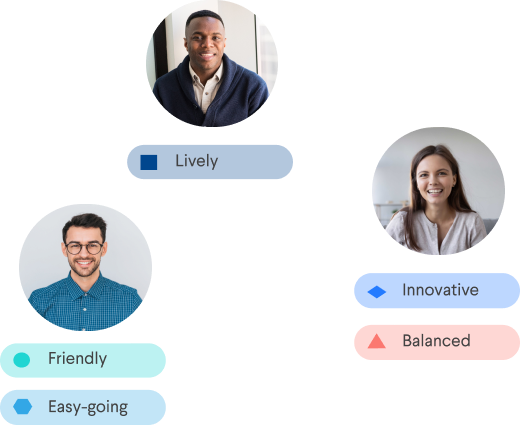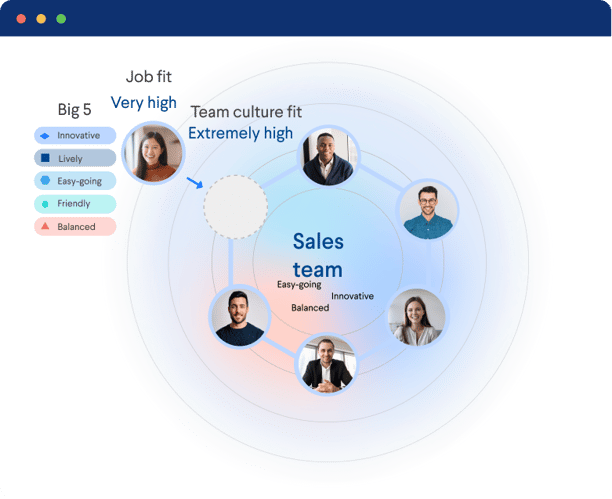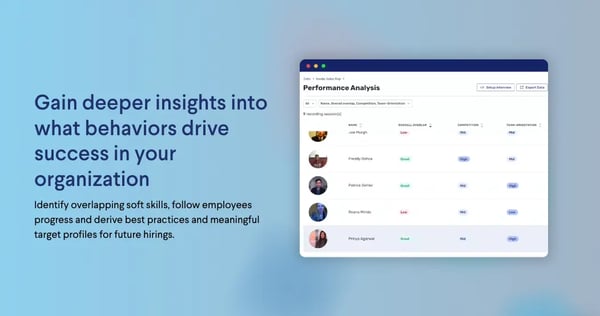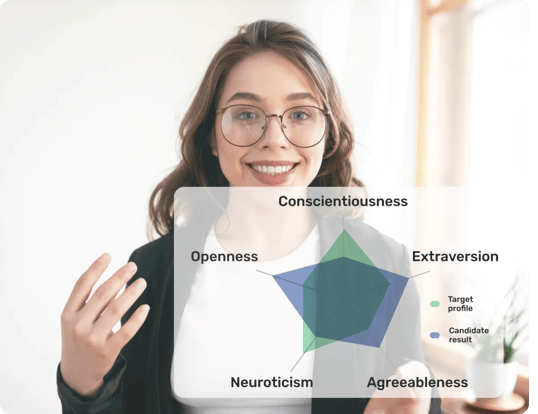Picture this: You're a sales representative who is constantly on a mission to lead conversations that generate sales for your company.
You have access to a video simulation platform where you can practice these client interactions, and ultimately trial and error various client conversations that help you fine-tune the soft skills you need to win over clients.
On top of that, you receive personalized feedback with a full behavior analysis, to make sure you understand exactly how you behave and what to do better to succeed at your role.
This is just one example of how behavioral analysis is helping workplaces globally improve employee behavior and well-being, including for one of the largest automotive brands in Germany.
With such fleeting market opportunities and a dynamic business landscape, behavior analysis is assuming a pivotal role in enhancing organizational effectiveness.
What's in this post?
- What is behavior analysis?
- Behavioral analysis examples in the business world
- Using AI for behavior analysis
- Behavioral Analysis in a hybrid world
What is Behavior Analysis?
In short, behavior analysis is the scientific study of behavior. It focuses on understanding why people behave the way that they do, and how their behaviors can be changed or improved. Behavior analysis utilizes the principles of learning theory and can help people better understand their behavior, and how to adapt it to improve their quality of life.
Applied behavior analysis (ABA)
Understanding human behaviors and their benefits have been widely recognized and explored extensively throughout history, including by Ole Ivar Lovaas in the 1960s, who coined the term applied behavior analysis (ABA). Applied behavior analysis is the broad scientific approach to understanding human behavior by clarifying the relevant behavior-environment interactions and using this to change one's behavior.
Behavioral Analysis Examples in the Business World
“Culture eats strategy for breakfast.” Or, in other words, employee behavior is what drives the success or failure of any business.
The bottom line is the employees who implement the plan matter the most.
Since the 1950s, behavior analysis is assuming a pivotal role in enhancing organizational effectiveness and competitive advantage for organizations globally, especially with the fast-paced changes we are witnessing in the business landscape. Behavioral analysis experts began deciding ways to influence employee actions with a mix of economics and psychology.
With such fleeting market opportunities and short-lived trends that require employees to adopt a mindset of continuous change and flexibility, the success of companies is largely dependent on their workers' ability to innovate and adapt.
That's where it becomes crucial for companies to put effort into their people's behavioral analysis and thus, understand what motivates them and how to develop their skills efficiently.

That's why the goal of the thousands of L&D departments that have been established over the last couple of years is to achieve sustainable behavior changes, improve communication patterns, and essentially cultivate a culture of continuous learning. When done right, employees should feel understood, heard, and fulfilled at their workplace and position.
Since learning is merely an event, but a process, which starts at the foundational level of understanding employee behavior, behavioral analysis becomes crucial. When companies don't understand what makes their employees tick, what motivates them, and how they like to learn, then any training efforts result in wasted time and money spent on e-Learning modules or training sessions.
Using AI for behavior analysis
Learning and development, and understanding behavior analysis, have moved into the digital world. To the relief of many L&D pro's around the globe today, we are seeing a breakthrough in the world of artificial intelligence (AI), and huge amounts of data are available to provide us with necessary insights, and measure things that were not considered measurable before. The rise in AI is ultimately creating new dimensions and redefining the concept of training employees.
In fact, not only is the adoption of AI helping companies gain insight into their people and thus increase revenue, but it is also decreasing costs, a study on The State of AI in 2020 by McKinsey found. Organizations are using AI as a tool for generating value, and increasingly, that value is coming in the form of revenue.
As we're seeing ongoing success in the machine learning scene, a lot of funding for AI research grants has been given, and spin-offs and start-ups are emerging at unprecedented rates.
Retorio is one of them. Currently in use by one of the biggest car retailers in Germany, along with many other companies around the world, Retorio's behavioral intelligence platform is paving the way in the behavior analysis scene. Its AI-powered video simulations allow employees to train their soft skills, as well as give them personalized feedback, helping them gain self-awareness.

Behavior Analysis in a Hybrid World
It's been over two years since the pandemic broke out, and despite many of us being thrown into a hybrid working model, this still remains the main working model to this day for many. Organizations were unprepared for the new skills they needed to continue their learning and development practice and maintain a positive learning environment (all while complying with social distancing measures caused by COVID-19). One of the clear shifts that had to be made was offering corporate learning and training to all employees, regardless of whether or not they were able to be physically in the office. This sparked a mega-trend in e-learning, and video training, as well as a huge demand for artificial intelligence (AI) training platforms.
In fact, companies globally recognized that video training creates an engaging solution for up-skilling employees that not only works in a hybrid working environment but is also easily scalable. Of the 2,000 companies that were looked at in a learning and development (L&D) report in 2019 already, 74% of trainers said that they used video learning as part of their training delivery.

Particularly in the retail sales area, where self-awareness and interpersonal skills can make or break a client deal, companies are recognizing the benefits of understanding their people through AI and behavior analysis.
If you're looking to improve your team's skills and provide them with personalized coaching, consider trying out Retorio today!
FAQ about Retorio's Training Platform:
1. How does Retorio's AI work?
Retorio works with a video-based Artificial Intelligence system that supports human intuition. Our technology is based on one of the most well-researched personality taxonomies, the so-called Big5 (or OCEAN) model, which has been validated as a reliable predictor of personality and job performance.
Our AI quantifies the behavior that participants of Retorio's assessment show in short video recordings; their facial expressions, gesture, language, and voice in order to derive a perceived personality prediction, meaning that our AI predicts how your candidates and their behavior would be perceived by a representative set of people.

2. How does the training platform work?
In the training overview, you’ll find all information necessary.
Firstly, you have a short introduction to the training, which gives you the underlying concepts of things you will learn in this training. Further, you will find the reason why this training will help you in your everyday work life.
The “What you’ll learn” section precisely shows you actions that are important in dealing with the client scenarios. Those are actions that you will be able to apply after you successfully finished the scenarios.
Lastly, you have the list of training scenarios. Choose from the virtual clients and “Start” interacting with them. If you already finished a scenario, the “See results” button will lead you to your prior results. If you want to improve your score, click on the “Do again” button to start another try. No worries, old results will still be visible to you even if you redo a scenario!


